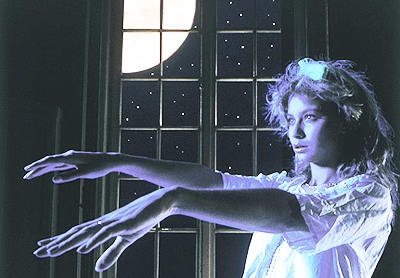Sleepwalking is a common phenomenon. Some people think that it is completely harmless: just a person walking around the house at night without much meaning. Others are afraid of such unfounded movements.
At the same time, somnambulism (this is how this problem is called in modern medicine) is quite widespread: it is observed in every fiftieth person on the planet. Accordingly, you need to know about it in order to understand in which cases you need help, and in which cases it will go away on its own.
Until the end of the 18th century, sleepwalking was considered a manifestation of the activity of evil spirits. Incomprehensible behavior, out of all standards, was thought-provoking, and also usually caused fear, bewilderment and, of course, misunderstanding. It was difficult for ordinary people to rationally explain such a situation. Accordingly, they fought the enemy using improvised methods: they read prayers and repented. Punitive measures were also applied to those who acted differently: there were often cases when they were simply accused of witchcraft and fought, like with other witches. Today, no one takes drastic measures against sleepwalkers, but at the same time, sudden episodes of sleepwalking can frighten even information-savvy modern citizens.
"It is not recommended to wake up." Somnologist on how to live with a sleepwalker Read more
Features and dangers of somnambulism
Nowadays, the term sleepwalking is no longer used, and people who tend to walk, gesticulate and talk in their sleep are called sleepwalkers only colloquially. Doctors call this sleep disorder somnambulism, and those who suffer from this disorder - somnambulists. And according to the dictionary of medical terms, somnambulism is a painful sleep disorder in which a person moves, talks or performs any actions while in a state of deep sleep.

Contrary to the common belief among the common people that sleepwalkers necessarily get out of bed and go outside the bedroom in their sleep, in most cases this disorder manifests itself less clearly. In general, doctors distinguish two forms of somnambulism - mild and severe, and each form of the disorder is characterized by the following:
- A mild form is a mild course of the disorder, in which attacks occur no more than 2-3 times a month, and the person does not get out of bed during attacks and does not perform any complex actions. As a rule, with a mild form of sleepwalking, people talk or grind their teeth in their sleep, and can also sit up in bed, gesticulate, pick up and move objects lying on the bedside table, etc.
- A severe form is a form of sleepwalking in which a person walks and performs complex actions in his sleep. Some sleepwalkers do household chores in their sleep, some eat, some simply wander around the house. During his “nightly adventures,” a sleepwalker can leave not only the bedroom, but also the house, walk to another area of the city, start a car, and even go to work or to see friends.

Regardless of the severity of the disorder, during nocturnal activity all sleepwalkers look almost the same - their eyes are wide open, their movements and gestures are somewhat constrained and mechanical, and there is practically no facial expression, which is why their facial expression seems detached. The attack of sleepwalking itself in most cases lasts a maximum of 30-40 minutes, although in psychiatric practice there have been cases when a person remained in a similar state for more than 2 hours. After the attack is over, the person returns to his bed, takes a comfortable position and sleeps peacefully until the morning. Waking up in the morning, the somnambulist will not remember anything that he did during the night attack.
Somnambulism itself, according to doctors, does not pose a particular danger to health and has little effect on the quality of sleep, since most sleepwalkers, even on those nights when they had attacks, slept well and felt cheerful and rested in the morning. However, there is still a danger in somnambulism , and it lies in the fact that when making any movements and actions in a dream, the somnambulist can be injured, provoke an accident, or even commit a crime. For example, sleepwalkers who go outside while sleeping can get hit by a car, and those who do household chores while asleep can drop something heavy on themselves, flood the apartment, or even open the valves on the gas stove.
Can a sleepwalker kill someone?
Most often not on purpose, because actions during sleepwalking are stereotypical, habitual and learned. A normal person doesn't try to strangle someone every day, does he? Of course, there are isolated unintentional murders in sleep, including children, suicides, but here it is necessary to study in detail whether this is connected with night terrors, in which a similar picture is observed. But if you try to disrupt his plans, try to wake him up, or turn out to be an obstacle on his way, then the chances of aggression on the part of the sleepwalker increase sharply. The sleeper may defend himself, especially if at that moment he is dreaming of something, and your actions will interfere with the content of the dream. So be careful.
Reasons why people sleepwalk at night
Sleepwalking only from the outside seems like something mysterious and even mystical, but for people suffering from this disorder, it is exclusively a cause of inconvenience, and sometimes even danger. Many somnambulists, aware of the danger looming over them, strive to prevent attacks with the help of sleeping pills, but such treatment is ineffective, because all such drugs sooner or later become addictive. Therefore, in order to cure this disorder, it is necessary to eliminate its cause. And according to doctors, in most cases the reasons why people sleepwalk at night are:
- Impaired brain functionality and the formation of a focus of epileptic readiness in the temporal lobe of the hemispheres. The brain of a completely healthy person “rests” during sleep, and those parts of the brain that are responsible for coordination of movements, control of limbs and speech are inactive in the deep sleep phase. However, in people who have nerve disorders or early stage epilepsy, brain function may be impaired. As a result of this disorder, during sleep, areas of the brain that should “rest” actively function and control the human body. As a rule, the results of the encephalogram of sleepwalkers show areas of the brain that are not functioning correctly.
- Severe stress. Stress, nervous breakdowns and increased anxiety negatively affect the functioning of the human nervous system, as a result of which malfunctions may occur in certain areas of the brain. Since each person’s psyche is individual, the consequences of nervous breakdowns are different for everyone - someone becomes irritable and aggressive, someone loses their ability to work, someone begins to experience memory problems, and someone “earns” sleep disorders and somnambulism .
People who engage in intellectual work and regularly endure excessive workloads sooner or later face the fact that their brain is unable to cope with the flow of information received. As a result, even during sleep, the brain cannot rest and tries to work at full capacity. Most often, it is for this reason that sleepwalking occurs in children and adolescents who have difficulty coping with school and extracurricular activities.
Excessive intellectual load.- Other sleep disturbances and deterioration in general health. Sometimes single attacks of sleepwalking occur in people suffering from chronic lack of sleep or insomnia, as well as in those who go to bed with a headache and fever. Both lack of sleep and physiological disorders in the body affect the functioning of the nervous system, which is why the brain may not completely switch to “sleep mode”, and certain parts of it will function in “wakefulness mode”.
If we consider the main reasons why people sleepwalk at night, we can conclude that the source of most of them are psychological problems - constant stress, inability to rest and relax, increased anxiety and inattention to one’s own health. And by eliminating these causes, you can significantly reduce the number of attacks of sleepwalking or completely get rid of somnambulism.
What is sleepwalking
The word “sleepwalking” (or scientifically “somnambulism”) comes from the Latin language. It is translated as “walking in a dream.” According to doctors, sleepwalking is a disorder of sleep processes. The disorder is associated with partial awakening of a person, and the reason for this is neurophysiological processes.
Somnambulism is a common phenomenon. According to medical statistics, 2-3% of the world's population speak and move in their sleep. And of the total number of people traveling at night, 8 out of 10 people are children.
How we sleep.
In a healthy person, after falling asleep, the phase of “slow” sleep begins, which lasts 1.5-2 hours. During this period, muscle tone is maintained in the human body, there are no dreams, and the sleeper periodically changes position. Then the time for REM sleep begins. In this phase, the muscles of the body relax, and dreams come to the sleeper. Over the entire period of sleep, the phases replace each other and repeat.
How does the disease appear?
If the nervous system during sleep is not able to control the brain areas that regulate human movement, sleepwalking occurs. Academician Pavlov, studying this problem, found out that in the process of healthy sleep in a person, nervous inhibition covers the cortex and subcortex of the cerebral hemispheres. And sleepwalking people leave the subcortex of their hemispheres “orphaned” when they sleepwalk.
Scientists were able to determine the moment of the onset of somnambulism, using a device that records brain bioelectrical activity (electroencephalograph). It turned out that sleepwalking begins at the stage of deep slow-wave sleep.
The brain of a person prone to sleepwalking is partially active, the sleeper moves in space, performs actions, actions, and is even capable of a simple discussion. The sleepwalker's eyes open. A sleeping person hears, touches, sees, maintains balance. But the feeling of fear in people when they sleepwalk is stopped, it is weakened. Therefore, somnambulists perform dangerous tricks that they would never risk doing in a normal state. After waking up, a person does not remember night walks.
Why "sleepwalking"?
This term appeared due to the strong human belief that walking and talking in a dream is influenced by the activity of the phases of the Moon. Who are sleepwalkers according to popular belief? Mentally ill people who liked to wander at night, especially during the full moon. This statement is erroneous, although the Moon can influence the human psyche.
Causes of sleepwalking
Unknowing people are sure that sleepwalking is a rare mental illness. This is wrong. Somnambulism is a type of nervous disorder. This problem affects sensitive, impressionable people with individual brain characteristics. In adults, the causes of sleepwalking lie in:
- Chronic fatigue.
- Long stressful situations.
- Insomnia, disordered sleep.
- Prolonged experiences.
- Congenital suspiciousness, anxiety.
- Increased personal emotionality.
Recent studies have proven that the cause of somnambulism is also hidden in genetics (if parents suffer from sleepwalking, the likelihood of a child developing a nighttime disorder reaches 60-65%). Epilepsy also becomes the culprit of sleepwalking. In this case, attacks of “sleepy activity” begin in the morning, they are of the same type and require appropriate treatment. In 2 cases out of 10, manifestations of somnambulism depend on physical and mental pathologies. These include:
- Abuse of alcohol and energy drinks.
- Holding your breath during sleep (apnea).
- Convulsive states.
- Complicated migraines.
- Head damage.
- Neuroinfections.
- Neuroses.
Childhood somnambulism begins as a result of immaturity of the nervous system; sleepwalking disappears with age. Attacks are provoked by emotional experiences, childhood phobias, impressionability, stress, and unpleasant situations.
In adolescents, somnambulism is provoked by age-related sensitivity (a period of crisis when the body is subjected to the greatest stress due to rapid development). Children's sleepwalking is often accompanied by enuresis (urinary incontinence) and nightmares. According to observations, boys are more susceptible to sleepwalking.
Features of the behavior of a sleepwalker
How do sleepwalkers behave?
When a sleeping person is overtaken by an attack of somnambulism and he begins to travel at night, his behavior changes. The movements are automated, sometimes smooth and soft, like a cat's. Looking into the eyes of a sleepwalker, you can notice that his pupils are constricted, and his gaze is frozen and cloudy, unseeing. A sleepwalker does not always make active, long movements at night - in 4 out of 10 cases he simply sits up in bed, sits and talks. The state of somnambulism lasts from 5-10 minutes to 1-1.5 hours.
Most often, attacks begin at the beginning of the night (the first third of the night), less often during daytime sleep. If a sleepwalker tends to walk in his sleep, accidents happen to him. A person confuses a window with a door and hurts himself, manipulates dangerous things, causing injuries to himself, drives a car in a dream, gets into an accident, and often resorts to violence.
There is a well-known case in America in the 80s when a man suffering from somnambulism got into a car in a dream, came to the house where his wife’s parents lived and killed them. The court found the criminal not guilty, since, while suffering from an attack, the sleepwalker did not remember and was not aware of his actions.
Somnambulists inflict unconscious damage to themselves in 25-30% of cases. There are known incidents when people climbed onto the roofs of houses, went swimming in nearby lakes, and went into shops. “Home” sleepwalkers wandered around the apartment, turning on household appliances and opening the refrigerator. In the morning, the sleepers calmly returned to bed and fell soundly asleep.
Clinical symptoms.
The nature of sleepwalking is varied. In medicine, somnambulism is characterized by the term “parasomnia.” Doctors record the following symptoms as clinical signs that indicate a person’s tendency to sleepwalk:
- Restless sleep with twitching of limbs.
- Frequent swallowing, smacking.
- Screaming and talking in your sleep.
In some patients, attacks are repeated every night, in others they are very rare and begin in moments of emotional upheaval and stress.
Ways to get rid of somnambulism

However, we cannot exclude a more serious and dangerous cause of somnambulism, namely the emergence of a focus of epileptic readiness in the brain. Therefore, in order to exclude this symptom or identify epilepsy at an early stage, people who have begun to walk at night need to undergo a full examination, including an encephalogram .
If the suspicion of a serious illness is not confirmed, the doctor will prescribe a complex treatment for the sleepwalker, which includes taking medications that improve the quality of sleep and have a sedative effect on the nervous system, and recommendations for maintaining a healthy lifestyle. Doctors also often recommend that somnambulists change their environment, go to a resort or sanatorium.

What happens during sleepwalking?
If you remember, that is, slow- and fast-wave sleep. Sleepwalking occurs when there is an “incorrect” awakening from slow-wave sleep, when consciousness and muscle activity are mismatched (the muscles have woken up, but the brain has not yet). As a result, it becomes possible to walk, talk and open your eyes. Similar phenomena can be observed in fast sleep (REM stage of sleep), but in this case the eyes will be closed (these will be disturbances in awakening in REM sleep).
Since slow-wave sleep predominates in the first half of the night, somnambulism is more often observed at the beginning of sleep.
Sleepwalking. Treatment.
Sleepwalking does not require special treatment. There is also no need to look for a psychiatrist or psychotherapist and drink mountains of calming pills. The main thing is to protect yourself and the sleepwalker from injuries from sharp objects and falls. Such moments do not last long; the “sleepwalker” will fall asleep on his own. You can only quietly guide him towards the bed, where he will safely lie down. The main thing is not to actively disturb him.
Sleepwalkers, somnambulists... We have all heard about these people, but many are convinced that this is a rare phenomenon. Not at all, somnambulism, or sleepwalking, as it is more often called “popularly,” is a fairly common disease, known since ancient times. Mentions of lunatics are found in the most ancient Egyptian papyri, in the books of Greek philosophers, and Roman annals.
Sleepwalking in those days was a mystery, and families that had sleepwalkers never brought this fact out to the public. This was considered dangerous: people suffering from sleepwalking were classified as sorcerers and witches, they could be expelled from the village and even burned or drowned. It was generally believed that such a person was possessed by evil spirits. But times have changed, and somnambulism has moved from the category of manifestations of an “unclean spirit” to the number of diseases treated by traditional medicine.
What to do if you have a sleepwalker at home?
- Lock the windows and doors in his room. It is better not to place the “sleepwalker’s” bedroom in a room with a balcony. An alarm for opening windows and doors would be useful.
- Round off all sharp corners in the apartment. Fortunately, there are special attachments for the corners of furniture designed to keep children safe. They will also be useful for adult somnambulists.
- Ensure good sleep hygiene. Read more in the "" section.
- Put away phones, gadgets, computer or TV before bed. Ideally, throughout the day to reduce the impact of flashing screens on brain activity.
- Avoid exposure to light, noise, and tactile stimuli during sleep.
- Calm down yourself.











